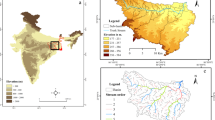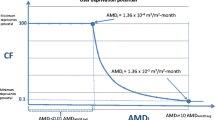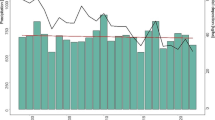Abstract
The proportion of hydroelectric participation in the Brazilian electricity matrix stretches beyond 65% of total energy generation, reaching around 248 GW. Much of this comes from the Amazon Basin, where more than half have not yet been explored. With the objective of assisting the development of hydroelectric plants in Brazil and other regions of the world, this study presents a numerical algorithm constructed from Scilab® software to calculate the optimum power for a hydropower plant that maximizes net financial benefits. The algorithm was applied to 57 fluviometric stations in nine drainage basins from different regions of Brazil, enabling the assessment of all relevant parameters for energy generation and economic analysis of hypothetical plants at each station, as well as analysis of the total hydroelectric energy potential of each basin. Energy potential in the studied basins exceeds 2 GW, generating more than 27 TWh/year. The economic results were related to energy, which allowed for a series of discussions about the hydroelectric market in Brazil. Finally, a study was conducted on the correlation between potential and the geometric, hydrological and perennial coefficients of the hydrographic basins. The correlations obtained were not satisfactory since heterogeneous and geographically distant hydrographic basins were used.

Source: Adapted from ELETROBRAS (2016b)


Source: Adapted from Cardoso et al. (2007)

Source: Santos et al. (2017)






Similar content being viewed by others
References
Akpinar, A. (2013). The contribution of hydropower in meeting electric energy needs: The case of Turkey. Renewable Energy, 51, 206–219.
Allouhi, A., Saadani, R., Buker, M. S., Kousksou, T., Jamil, A., & Rahmoune, M. (2018). Energetic, economic and environmental (3E) analyses and LCOE estimation of three technologies of PV grid-connected systems under different climates. Solar Energy, 178, 25–36.
ANA. (2018a). National Water Agency. Hidroweb Portal (in Portuguese). Retrieved February 20, 2018 from http://www.snirh.gov.br/hidroweb/publico/apresentacao.jsf.
ANA. (2018b). National Water Agency. Hidro 1.3 (in Portuguese). Retrieved March 3, 2018 from http://www.snirh.gov.br/hidroweb/publico/baixar_documento.jsf.
Andrade, F. M. N. (2012). A preliminary analysis of the electricity market of the isolated electrical system of Manaus. Masters dissertation. Business Economics, Catholic University of Brasilia (in Portuguese).
ANEEL. (2016). National Electric Energy Agency. Distributed Generation (in Portuguese). Retrieved April 10, 2017 from http://www.aneel.gov.br/informacoestecnicas//asset_publisher/CegkWaVJWF5E/content/geracao-distribuida-introduc-1/656827?inheritRedirect=false.
ANEEL. (2018). National Electric Energy Agency—BIG: Generation Information Bank (in Portuguese). Retrieved February 18, 2018 from http://www2.aneel.gov.br/aplicacoes/capacidadebrasil/capacidadebrasil.cfm.
Arias-Gaviria, J., Carvajal-Quintero, S. X., & Arango-Aramburo, S. (2019). Understanding dynamics and policy for renewable energy diffusion in Colombia. Renewable Energy, 139, 1111–1119.
Bayazit, Y., Bakis, R., & Koç, C. (2017). An investigation of small scale hydropower plants using the geographic information system. Renewable and Sustainable Energy Reviews, 67, 289–294.
Botan, J. S., & Ottoni, A. B. (2012). Methodology of analysis of the water economy in degraded basins: case study of the Jaguari River Basin/MG-SP. Rio (in Portuguese).
BRASIL. (2018). Federal Revenue. SELIC interest rate (in Portuguese). Retrieved May 20, 2018 from http://idg.receita.fazenda.gov.br/orientacao/tributaria/pagamentos-e-parcelamentos/taxa-de-juros-selic.
BRASIL. (2019). Portal for scientific and technological dissemination. Environmental licensing of hydroelectrics. Retrieved September, 2018 from http://www.canalciencia.ibict.br/pesquisa/0248-Licenciamento-ambiental-hidreletricas.html.
Brazil Central Bank. Citizen Calculator (in Portuguese). Retrieved May 28, 2018 from https://www3.bcb.gov.br/CALCIDADAO/publico/exibirFormCorrecaoValores.do?method=exibirFormCorrecaoValores&aba=1.
Butera, I., & Balestra, R. (2015). Estimation of the hydropower potential of irrigation networks. Renewable and Sustainable Energy Reviews, 48, 140–151.
Cardoso, R. B., Almeida, R. P., & Nogueira, L. A. H. (2007). An evaluation of the Expedito Method to determine the project flow in Small Hydropower Plants. PCH Notícias & SHP News, 33, 10–14 (in Portuguese).
Costa, T. F. (2017). Study of the hydroenergetic potential of watersheds by means of algorithm in Scilab® software. Final Graduation Work (Hydric Engineering). Federal University of Itajubá (MG) (in Portuguese).
CPFL. (2015). Energy Company (in Portuguese). Report V—Formation of costs and prices of electricity generation and transmission. Retrieved May 28, 2018 from https://www.cpfl.com.br/energias-sustentaveis/inovacao/projetos/Documents/PB3002/formacao-de-custos-e-precos-de-geracao-e-transmissao.pdf.
De Jong, P., Kiperstok, A., & Torres, E. A. (2015). Economic and environmental analysis of electricity generation technologies in Brazil. Renewable and Sustainable Energy Reviews, 52, 725–739.
EFE. Agency EFE. (2019). European Commission warns Brazil of compliance with Paris Agreement (in Portuguese). Retrieved September, 2018 from https://www.efe.com/efe/brasil/brasil/comiss-o-europeia-envia-alerta-ao-brasil-sobre-cumprimento-do-acordo-de-paris/50000239-4057204.
ELETROBRAS. (2016a). Brazilian Hydroelectric Potential in each Stage by Hydrographic Basin. Eletrobras (in Portuguese). Retrieved November 9, 2017 from http://eletrobras.com/pt/AreasdeAtuacao/geracao/sipot/Potencial%20Hidreletrico%20Brasileiro%20por%20Bacia%20-%20Dezembro%202016.pdf.
ELETROBRAS. (2016b). Brazilian Hydroelectric Potential in each Stage by State. Eletrobras (in Portuguese). Retrieved February 20, 2018 from http://eletrobras.com/pt/AreasdeAtuacao/geracao/sipot/Potencial%20Hidreletrico%20Brasileiro%20por%20Estagio%20-%20Dezembro%202016.pdf.
CANAL ENERGIA. (2016). Prices for A-5 vary from R 115/MWh to R 290/MWh (in Portuguese). Retrieved May 20, 2018 from https://www.canalenergia.com.br/noticias/4926987/precos-do-a5-variam-de-r-115mwh-a-r-290mwh.
EPE. Energy Research Company. (2017b). Statistical Yearbook of Electrical Energy 2017—base year 2016 (in Portuguese). Retrieved June 1, 2018 from http://www.epe.gov.br/sites-pt/publicacoes-dados-abertos/publicacoes/PublicacoesArquivos/publicacao-160/topico-168/Anuario2017vf.pdf.
EPE. Energy Research Company. BEN—National Energy Balance. (2017a). Retrieved October 2, 2017 from https://ben.epe.gov.br/downloads/S%C3%ADntese%20do%20Relat%C3%B3rio%20Final_2017_Web.pdf (in Portuguese).
Faria, F. A. M., & Jaramillo, P. (2017). The future of power generation in Brazil: An analysis of alternatives to Amazonian hydropower development. Energy for Sustainable Development, 41, 24–35.
Fearnside, P. M. (2015). Hydropower in the Amazon. Environmental and social impacts in decision-making on large works. National Institute of Research of the Amazon (INPA) (in Portuguese). Retrieved August 28, 2018 from http://philip.inpa.gov.br/publ_livres/2015/Livro-Hidro-V1/Livro%20Hidrel%C3%A9tricas%20V.1.pdf.
Ferreira, J. H. I., Camacho, J. R., Malagoli, J. A., & Guimarães, S. C., Jr. (2016). Assessment of the potential of small hydropower development in Brazil. Renewable and Sustainable Energy Reviews, 56, 380–387.
Fetter, C. W. (2001). Applied hydrogeology, 4 edn. University of Wisconsin—Oshkosh. Prentice Hall.
IHA. Hydropower Status Report. (2017). International hydropower association (IHA), Sutton, United Kingdom. Retrieved September, 2019 from https://www.hydropower.org/sites/default/files/publications-docs/2017%20Hydropower%20Status%20Report.pdf.
INEE. National Institute of Energy Efficiency. (2017). What is distributed generation (in Portuguese). Retrieved October 4, 2017 from http://www.inee.org.br/forum_ger_distrib.asp.
IRENA. International Renewable Energy Agency. (2012). Hydropower. Renewable energy technologies: cost analysis series. Vol. 1.
IRENA. International Renewable Energy Agency. Hydropower. Retrieved September 18, 2019 from https://www.irena.org/costs/Power-Generation-Costs/Hydropower.
Kelman, R. (2014). The great role of the Brazilian hydroelectric potential. National Academy of Engineering (ANE) (in Portuguese). Retrieved May 28, 2018 from http://anebrasil.org.br/wp-content/uploads/2014/10/o-potencial-hidreletrico-brasileiro1.pdf.
Lanna, A. E. (2015). Seminar on the granting and allocation of water in critical basins. National Water Agency (ANA) (in Portuguese). Retrieved November, 2018 from http://arquivos.ana.gov.br/imprensa/eventosprojetos/20150707_BaciasCriticasPorExpansaoDaDemandaProblemaEPossiveisSolucoes-ProfAntonioLana.pdf.
Martinez, J., Deng, Z. D., Tian, C., Mueller, R., Phonekhampheng, O., Singhanouvong, D., et al. (2019). In situ characterization of turbine hydraulic environment to support development of fish-friendly hydropower guidelines in the lower Mekong River region. Ecological Engineering, 133, 88–97.
Mensah, J. H. R. (2016). Analysis of the spatial distribution of flows, energy potential and economic feasibility of hydroelectric projects in Rio Grande, MG. Monography (Undergraduate Degree in Water Engineering)—Federal University of Itajubá. Itajubá, 2016 (in Portuguese).
Mensah, J. H. R., Santos, I. F. S., & Martins, A. M. (2017). Analysis of the spatial distribution of flows, energy potential and economic feasibility of hydroelectric projects in Rio Grande, MG. PCH Notícias & SHP News, 72, 5–11 (in Portuguese).
MMA. Brazilian Ministry of Environmental Management. Paris Agreement (in Portuguese). Retrieved September, 2019 from https://www.mma.gov.br/clima/convencao-das-nacoes-unidas/acordo-de-paris.
Nguyen, P. A., Abbott, M., & Nguyen, T. L. T. (2019). The development and cost of renewable energy resources in Vietnam. Utilities Policy, 57, 59–66.
NREL. (2019). USA National Renewable Energy Laboratory, Simple leveled cost ofenergy (LCOE) calculator documentation. Retrieved January 11, 2019 from https://www.nrel.gov/analysis/tech-lcoe-documentation.html.
Ogino, K., Dash, S. K., & Nakayama, M. (2019). Change to hydropower development in Bhutan and Nepal. Energy for Sustainable Development, 50, 1–17.
Ostojic, G., et al. (2013). 100% Development of hydro potential in Republic Srpska. Renewable and Sustainable Energy Reviews, 28, 196–203.
Pang, M., Zhang, L., Wang, C., & Liu, G. (2015). Environmental life cycle assessment of a small hydropower plant in China. The International Journal of Life Cycle Assessment, 20, 796–806.
Penghao, C., Pingkuo, L., & Hua, P. (2019). Prospects of hydropower industry in the Yangtze River Basin: China’s green energy choice. Renewable Energy, 131, 1168–1185.
Prudente, E. P. (2017). Procedure for assessing the maximum hydroenergetic utilization of a river basin. Dissertation (Master in Energy Engineering). Federal University of Itajubá. Itajubá, Brazil (in Portuguese).
Resende, M. G. (2013). Development of a Scilab® computer program based on the Pinch method of energy integration. Master’s Dissertation in Chemical Engineering. University of São Carlos (in Portuguese).
Resende, M. G., & Kwong, W. H. (2014). Elaboration of a Scilab® software for basic calculations of energy integration. In XX Brazilian congress of chemical engineering, Florianópolis (in Portuguese).
Scilab 6.0.1. Retrieved April 28, 2018 from https://www.scilab.org/download/6.0.1.
Santos, I. F. S., Camacho, R. G. R., Tiago Filho, G. L., Botan, A. C. B., & Vinent, B. A. (2019). Energy potential and economic analysis of hydrokinetic turbines implementation in rivers: An approach using numerical predictions (CFD) and experimental data. Renewable Energy, 143, 648–662.
Santos, A. M., Targa, Batista, G. T., & Dias, N. W. (2012). Morphometric analysis of the Perdizes and Fojo sub-basins in the city of Campos do Jordão, SP, Brazil. Environmental & Water Journal—An Interdisciplinary Journal of Applied Science, 7(3), 195–211 (in Portuguese).
Santos, I. F. S., Tiago Filho, G. L., Barros, R. M., & Fernandes, G. L. (2017). Optimization and financial risk analysis of small hydro power (SHPs) dimensioning, considering the CDM benefits. American Journal of Hydropower, Water and Environment Systems. 4.
Santos, I. F. S., Tiago Filho, G. L., Barros, R. M., & Lemos, H. (2015). Adjustment and evaluation of aggregate models of estimated SHP cost in Brazil. Work & Engenho, 9(3), 13–22 (in Portuguese).
Santos, I. F., Tiago Filho, G. L., Barros, R. M., & Silva, F. G. B. (2016). Sensibility analysis of economically optimum scenarios of a small hydropower (SHP) implementation project in Brazil. PCH Notícias & SHP News, 68, 9–14.
Soito, J. L. S., & Freitas, M. A. V. (2011). Amazon and the expansion of hydropower in Brazil: Vulnerability, impacts and possibilities for adaptation to global climate change. Renewable and Sustainable Energy Reviews, 15, 3165–3177.
Souza, Z., Tiago Filho, G. L., Barros, R. M., Santos, I. F. S., Silva, F. G. B., Leite, M. D. P., et al. (2017). The limit of sequential exploitation of a river’s hydraulic potential. Renewable and Sustainable Energy Reviews, 68, 272–285.
Supriyasilp, T., Pongput, K., & Boonyasirikul, K. (2009). Hydropower development priority using MCDM method. Energy Policy, 37, 1866–1875.
Tiago Filho, G. L. (2011). Financial economic viability of the development of SHP projects. In VII Conference of hydroelectric power plants, convention center of Novotel Center Norte, São Paulo, 03 and 04 August 2011 (in Portuguese).
Tiago Filho, G. L., Santos, I. F. S., & Barros, R. M. (2017). Cost estimate of small hydroelectric power plants based on the aspect factor. Renewable and Sustainable Energy Reviews, 77, 229–238.
Tonello, K. C., Dias, H. C. T., Souza, A. L., Ribeiro, C. A. A. S., & Leite, F. P. (2006). Morphometry of the catchment area of Cachoeira das Pombas, Guanhães, MG. Tree Magazine, Viçosa-MG (Vol. 30, No. 5, pp. 849–857) (in Portuguese).
Trajano, S. R. R. S., Spadotto, C. A., Holler, W. A., Daltio, J., Martinho, P. R. R., Fois, N. S., et al. (2012). Morphometric analysis of river basin: subsidy to territorial management, case study in upper and middle Mamanguape. Campinas, SP: Research and Development Bulletin/Embrapa Territorial Management (in Portuguese).
Tucci, C. E. M. (2012). Hydrology—Science and application, 4th edn. Porto Alegre (RS): Publisher of UFRGS/ABRH (in Portuguese).
Tundisi, J. G. (2007). Exploration of the Amazonian hydroelectric potential. Advanced Studies, 21, 109–117 (in Portuguese).
Veiga, A. M., Santos, C. C. P., Cardoso, M. R. D., & Lino, N. C. (2013). Hydromorphological characterization of the Meia Ponte river basin. Paths of Geography Magazine, 14(46), 126–138 (in Portuguese).
Villela, S. M., & Mattos, A. (1975). Applied hydrology (p. 245). São Paulo: McGRAWHill of Brasil in Portuguese.
Von Sperling, E. (2012). Hydropower in Brazil: Overview of positive and negative environmental aspects. Energy Procedia, 18, 110–118.
Wagner, B., Hauer, C., & Habersack, H. (2019). Current hydropower developments in Europe. Current Opinion in Environmental Sustainability, 37, 41–49.
Acknowledgements
We thank the Coordinator of the Improvement of Higher Education Personnel (Coordenação de Aperfeiçoamento de Pessoal de Nível Superior, CAPES; in Portuguese) for the given support to Ivan Felipe Silva dos Santos and to the Brazilian National Council for Scientific and Technological Development (Conselho Nacional de Desenvolvimento Científico e Tecnológico, CNPq; in Portuguese), for granting productivity in research scholarship to Prof. Regina Mambeli Barros (PQ2, Process Numbers: 303805/2018-0 and 301986/2015-0).
Author information
Authors and Affiliations
Corresponding author
Additional information
Publisher's Note
Springer Nature remains neutral with regard to jurisdictional claims in published maps and institutional affiliations.
Appendix 1: Algorithm developed in Scilab® software
Appendix 1: Algorithm developed in Scilab® software



Rights and permissions
About this article
Cite this article
Costa, T.F., dos Santos, I.F.S., Tiago Filho, G.L. et al. Optimum hydropower potential study on nine Brazilian drainage basins using a numerical algorithm. Environ Dev Sustain 23, 1729–1758 (2021). https://doi.org/10.1007/s10668-020-00648-7
Received:
Accepted:
Published:
Issue Date:
DOI: https://doi.org/10.1007/s10668-020-00648-7




